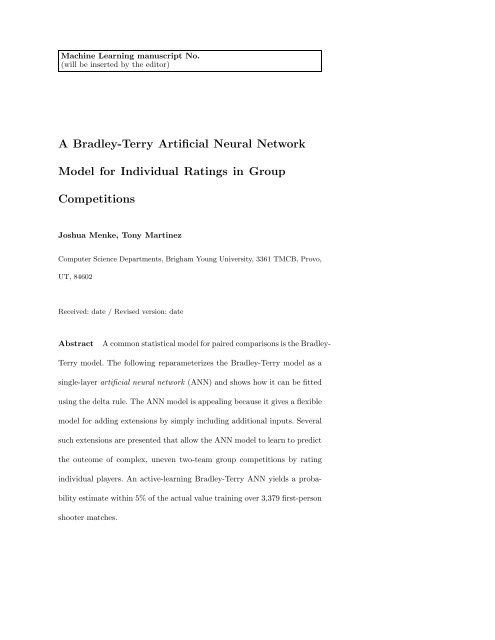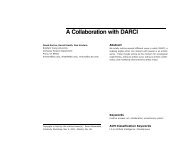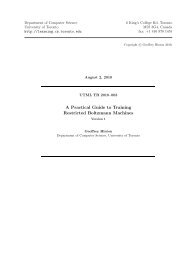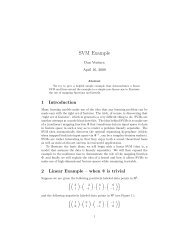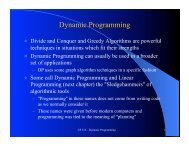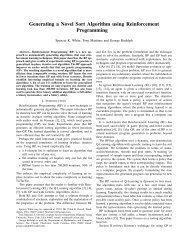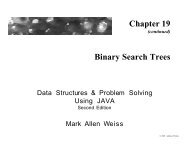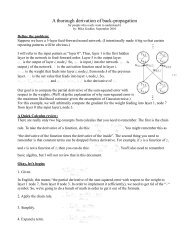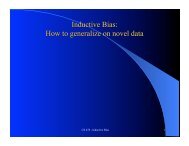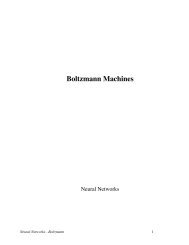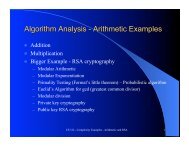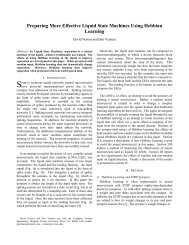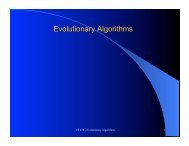A Bradley-Terry Artificial Neural Network Model for Individual ...
A Bradley-Terry Artificial Neural Network Model for Individual ...
A Bradley-Terry Artificial Neural Network Model for Individual ...
Create successful ePaper yourself
Turn your PDF publications into a flip-book with our unique Google optimized e-Paper software.
Machine Learning manuscript No.<br />
(will be inserted by the editor)<br />
A <strong>Bradley</strong>-<strong>Terry</strong> <strong>Artificial</strong> <strong>Neural</strong> <strong>Network</strong><br />
<strong>Model</strong> <strong>for</strong> <strong>Individual</strong> Ratings in Group<br />
Competitions<br />
Joshua Menke, Tony Martinez<br />
Computer Science Departments, Brigham Young University, 3361 TMCB, Provo,<br />
UT, 84602<br />
Received: date / Revised version: date<br />
Abstract A common statistical model <strong>for</strong> paired comparisons is the <strong>Bradley</strong>-<br />
<strong>Terry</strong> model. The following reparameterizes the <strong>Bradley</strong>-<strong>Terry</strong> model as a<br />
single-layer artificial neural network (ANN) and shows how it can be fitted<br />
using the delta rule. The ANN model is appealing because it gives a flexible<br />
model <strong>for</strong> adding extensions by simply including additional inputs. Several<br />
such extensions are presented that allow the ANN model to learn to predict<br />
the outcome of complex, uneven two-team group competitions by rating<br />
individual players. An active-learning <strong>Bradley</strong>-<strong>Terry</strong> ANN yields a probability<br />
estimate within 5% of the actual value training over 3,379 first-person<br />
shooter matches.
2 Joshua Menke, Tony Martinez<br />
1 Introduction<br />
The <strong>Bradley</strong>-<strong>Terry</strong> model is well known <strong>for</strong> its use in statistics <strong>for</strong> paired<br />
comparisons (<strong>Bradley</strong> & <strong>Terry</strong>, 1952; Davidson & Farquhar, 1976; David,<br />
1988; Hunter, 2004). It has also been applied in machine learning to obtain<br />
multi-class probability estimates (Hastie & Tibshirani, 1998; Zadrozny,<br />
2001; Huang, Lin, & Weng, 2005). The original model says given two subjects<br />
of strengths λ A and λ B , the probability that subject A will defeat or<br />
is better than subject B in a paired-comparison or competition is:<br />
Pr(A def. B) =<br />
λ A<br />
λ A + λ B<br />
. (1)<br />
<strong>Bradley</strong>-<strong>Terry</strong> maximum likelihood models are often fit using methods like<br />
Markov Chain Monte Carlo (MCMC) integration or fixed-point algorithms<br />
that seek the mode of the negative log-likelihood function (Hunter, 2004).<br />
These methods however, “are inadequate <strong>for</strong> large populations of competitors<br />
because the computation becomes intractable.” (Glickman, 1999). The<br />
following paper presents a method <strong>for</strong> determining the ratings of over 4,000<br />
players over 3,379 competitions.<br />
Elo (see, <strong>for</strong> example, (Glickman, 1999)) invented an efficient approach<br />
to iteratively learn the ratings of thousands of players competing in thousands<br />
of chess tournaments. The currently used “ELO Rating System” reparameterizes<br />
the <strong>Bradley</strong>-<strong>Terry</strong> model by setting λ A = e θA yielding:<br />
Pr(A def B) =<br />
1<br />
1 + 10 − θ A −θ B<br />
400<br />
. (2)
An ANN <strong>Model</strong> For <strong>Individual</strong> Ratings in Group Competitions 3<br />
Fig. 1 The <strong>Bradley</strong>-<strong>Terry</strong> Modle as a Single-Layer ANN<br />
The scale specific parameters are historical only and can be changed to the<br />
following:<br />
1<br />
Pr(A def B) = . (3)<br />
1 + e−(θA−θB) Substituting w <strong>for</strong> θ in (3) yields the single-layer artificial neural network<br />
(ANN) in figure 1. This single-layer sigmoid node ANN can be viewed as a<br />
<strong>Bradley</strong>-<strong>Terry</strong> model where the input corresponding to subject A is always<br />
1, and B, always −1. The weights w A and w B correspond to the <strong>Bradley</strong>-<br />
<strong>Terry</strong> strengths θ A and θ B —often referred to as ratings. The <strong>Bradley</strong>-<strong>Terry</strong><br />
ANN model can be fit by using the standard delta rule training method<br />
<strong>for</strong> single-layer ANNs. This ANN interpretation is appealing because many<br />
types of common extensions can be added simply as additional inputs to<br />
the ANN.
4 Joshua Menke, Tony Martinez<br />
The <strong>Bradley</strong>-<strong>Terry</strong> model that Elo’s method will fit can learn the ratings<br />
of subjects competing against other subjects, but does not provide <strong>for</strong> the<br />
case where each subject is a group and the goal is to obtain the ratings of<br />
the individuals in the group. The following presents a model that can give<br />
individual ratings from groups and shows further extensions of the model to<br />
handle “home field advantage”, weighting players by contribution, dealing<br />
with variable sized groups, and other issues. The probability estimates given<br />
by the final model are accurate to within 5% of the actual observed values<br />
over 3,379 competitions in an objective-oriented online first-person shooter.<br />
This article will proceed as follows: section 2 gives more background on<br />
prior uses and methods <strong>for</strong> the fitting of <strong>Bradley</strong>-<strong>Terry</strong> models, section 3<br />
explains the proposed model, extensions, and how to fit it, section 4 explains<br />
how the model is evaluated, section 5 gives results and analysis of<br />
the model’s evaluations, a discussion of possible applications of the model<br />
are given in section 6, and section 7 gives conclusions and future research<br />
directions.<br />
2 Background<br />
The <strong>Bradley</strong>-<strong>Terry</strong> model was originally introduced in (<strong>Bradley</strong> & <strong>Terry</strong>,<br />
1952). It has been widely applied in situations where the strength of a particular<br />
choice or individual needs to be evaluated with respect to another.<br />
This includes sports and other competitive applications. Reviews on the<br />
extensions and methods of fitting <strong>Bradley</strong>-<strong>Terry</strong> models can be found in
An ANN <strong>Model</strong> For <strong>Individual</strong> Ratings in Group Competitions 5<br />
(<strong>Bradley</strong> & <strong>Terry</strong>, 1952; Davidson & Farquhar, 1976; David, 1988; Hunter,<br />
2004). This paper differs from previous research in two ways. First, it proposes<br />
a method to determine individual ratings and rankings when the subjects<br />
being compared are groups. (Huang et al., 2005) proposed a similar<br />
extension, however their method of fitting the model assumes that “each<br />
individual <strong>for</strong>ms a winning or losing team in some competitions which together<br />
involve all subjects” In situations involving thousands of players on<br />
teams that may never compete against each other, their method is not guaranteed<br />
to converge. In addition, they could not prove the method of fitting<br />
would converge to the global minimum. The following method, however, will<br />
always converge to the global minimum because it is an ANN trained with<br />
the delta rule—a method whose convergence properties are well-known. Perhaps<br />
more importantly, the model proposed by (Huang et al., 2005) fits each<br />
parameter simultaneously, which is both impractical when the amount of<br />
competitions and individuals is large, and undesirable if the model needs to<br />
be updated after every competition. This is because new individuals may<br />
enter the model at any point, and there<strong>for</strong>e it is impossible to know when<br />
to stop and fit all the individual parameters. This leads to the second additional<br />
contribution of this paper.<br />
The more common methods <strong>for</strong> fitting a <strong>Bradley</strong>-<strong>Terry</strong> model require<br />
that all of the comparisons to be considered involving all of the competitors<br />
have already taken place so the model can be fit simultaneously. While this<br />
can be more theoretically accurate, it is intractable in situations involving
6 Joshua Menke, Tony Martinez<br />
thousands of comparisions and competitors. In addition, as mentioned, it is<br />
impossible to fit a model this way if new individuals can be added at any<br />
point. Elo and (Glickman, 1999) have both proposed methods <strong>for</strong> approximating<br />
a simultaneous fit by by adapting the <strong>Bradley</strong>-<strong>Terry</strong> model after<br />
every comparison. This also allows <strong>for</strong> new individuals to be inserted at any<br />
point in the model. However, neither of these methods has been extended to<br />
extract individual ratings from groups. The model presented here does allow<br />
individual ratings to be determined in addition to providing an efficient<br />
update after each comparison.<br />
3 The ANN <strong>Model</strong><br />
The section proceeds as follows: it first presents the basic framework <strong>for</strong><br />
viewing the <strong>Bradley</strong>-<strong>Terry</strong> model as a delta-rule trained single layer ANN<br />
in 3.1, then the next section, 3.2 will show how to extend the model to<br />
learn individual ratings within a group, 3.3 extends the model to allow<br />
different weights <strong>for</strong> each individual based on their contribution, 3.4 shows<br />
how the model can be extened to learn “home field” advantages, 3.5 presents<br />
a heuristic to deal with uncertainty in an individual’s rating, and 3.6 gives<br />
another heuristic <strong>for</strong> preventing rating inflation.<br />
3.1 The Basic <strong>Model</strong><br />
The basis <strong>for</strong> the <strong>Bradley</strong>-<strong>Terry</strong> ANN <strong>Model</strong> begins with the ANN shown<br />
in figure 1. Assuming, without loss of generality, that group A is always the
An ANN <strong>Model</strong> For <strong>Individual</strong> Ratings in Group Competitions 7<br />
winner and the question asked is always what is the probability that team<br />
A will win, the input <strong>for</strong> w A will always be 1 and the input <strong>for</strong> w B will<br />
always be −1. The equation <strong>for</strong> the model can be written as:<br />
1<br />
Output = Pr(A def B) =<br />
. (4)<br />
1 + e−(wA−wB) which is the same as (3), except w A and w B are substituted <strong>for</strong> θ A and θ B .<br />
The model is updated applying the delta rule which is written as follows:<br />
∆w i = ηδx i (5)<br />
where η is a learning rate, δ is the error measured with respect to the output,<br />
and x i is the input <strong>for</strong> w i . The error, δ is usually measured as:<br />
δ = Target Output − Actual Output. (6)<br />
For the ANN <strong>Bradley</strong>-<strong>Terry</strong> model, the target output is always 1 given the<br />
assumption that A will defeat B. The actual output is the output of the<br />
single node ANN. There<strong>for</strong>e, the delta rule error can be rewritten as:<br />
δ = 1 − Pr(A def. B) = 1 − Output, (7)<br />
and the weight updates can be written as:<br />
∆w A = η(1 − Output) (8)<br />
∆w B = −η(1 − Output) (9)<br />
Here, x i is implicit as 1 <strong>for</strong> w A and −1 <strong>for</strong> w B , again since A is assumed to<br />
be the winning team. It is well-known that a single-layer ANN trained with<br />
the delta rule will converge to the global minimum as long as the learning
8 Joshua Menke, Tony Martinez<br />
rate is low enough. This is because the delta rule is using gradient descent<br />
on an error surface that is strictly convex. Notice that the <strong>for</strong>mulation of<br />
the delta rule in (5) does not include the derivative of the sigmoid. The<br />
sigmoid’s derivative, namely Ouput(1 − Output), is also the inverse of the<br />
derivative of a different objective function called cross-entropy. There<strong>for</strong>e,<br />
this version of the delta rule is minimizing the cross-entropy instead of the<br />
squared-error. The cross-entropy of a model is also known as the negative<br />
log-likelihood. This is appealing because the resulting fit will produce the<br />
maximum likelihood estimator. Despite not strictly minimizing the squarederror,<br />
this method will still converge to the global minimum because the<br />
direction of the gradient <strong>for</strong> minimizing either function is always the same. In<br />
summary, the standard <strong>Bradley</strong>-<strong>Terry</strong> model can be fit by reparameterizing<br />
it as a single-layer ANN, and then training it with the delta rule.<br />
3.2 Individial Ratings from Groups<br />
In order to extend the ANN model given in 3.1 to learn individual ratings,<br />
the weights <strong>for</strong> each group are obtained by averaging the ratings of the individuals<br />
in each group. Huang et. al (Huang et al., 2005) used the sum of<br />
each group which in the ANN model is analagous to having each individual<br />
have an input of 1 if they are on the winning team, −1 if they are on<br />
the losing team, and 0 if they are absent. This model assumes that when<br />
there are an uneven number of individuals on each team, the effect of one<br />
individual is the same in all situations. Here the average is used instead so
An ANN <strong>Model</strong> For <strong>Individual</strong> Ratings in Group Competitions 9<br />
that the effect of a difference in the number of individuals can be handled<br />
separately. For example, the home field advantage <strong>for</strong>mulation in section<br />
3.4 uses the relative number of individuals per group as an explicit input<br />
into the ANN. Averaging instead of summing the ratings is also analogous<br />
to normalizing the inputs—a common practice in efficiently training ANNs.<br />
Neither method changes the convergence properties because the error surface<br />
is still strictly convex and the weight updates are still in the correct<br />
direction.<br />
As stated, the weights <strong>for</strong> the ANN model in 1 are obtained as follows:<br />
w A =<br />
w B =<br />
∑<br />
i∈A θ i<br />
(10)<br />
N<br />
∑ A<br />
i∈B θ i<br />
(11)<br />
N B<br />
Where i ∈ A means player i belongs to group A and N A is the number of<br />
individuals in group A. Combining individual ratings in this manner means<br />
that the difference in the perfomance between two different players within<br />
a single competition can not be distinguished. However, after two players<br />
have competed within several different teams, their ratings can diverge. The<br />
weight update <strong>for</strong> each player θ i is equal to the update <strong>for</strong> ∆w team given in<br />
(8):<br />
∀i ∈ A,∆θ i = η(1 − Output) (12)<br />
∀i ∈ B,∆θ i = −η(1 − Output) (13)<br />
where A is the winning team and B is the losing team. In this model,<br />
instead of updating w A and w B directly, each individual receives the same
10 Joshua Menke, Tony Martinez<br />
update, there<strong>for</strong>e indirectly changing the average team ratings w i by the<br />
same amount the update in (8) does <strong>for</strong> ∆w A and ∆w B .<br />
3.3 Weighting Player Contribution<br />
Depending on the type of competition, prior knowledge may suggest certain<br />
individuals within a group are more or less important despite their<br />
ratings. As an example, consider a public online multiplayer competition<br />
where players are free to join and leave either team at any time. All else<br />
being equal, players that remain in the competition longer are expected to<br />
contribute more to the outcome than those who leave early, join late, or divide<br />
their time between teams. There<strong>for</strong>e, it would be appropriate to weight<br />
each player’s contribution to w A or w B by the length of time they spent on<br />
team A and team B. In addition, the update to each player’s rating should<br />
also be weighted by the amount of time the player spends on both teams.<br />
There<strong>for</strong>e, w A is rewritten as an average weighted by time played on both<br />
teams:<br />
w A = ∑ i∈A<br />
t i A<br />
θ i ∑<br />
j∈A tj A<br />
. (14)<br />
Here, t i A means the amount of time player i spent on team A. Weighting can<br />
be used <strong>for</strong> more than just the amount of time an individual participates in a<br />
competition. For example, in sports, it may have been previously determined<br />
that a given position is more important than another. The general <strong>for</strong>m <strong>for</strong>
An ANN <strong>Model</strong> For <strong>Individual</strong> Ratings in Group Competitions 11<br />
adding weighting to the model is:<br />
w A = ∑ i∈A<br />
c i<br />
θ i ∑j∈A<br />
cj<br />
. (15)<br />
where c i is the the contribution weight of individual i. This gives an average<br />
that is weighted by each individual’s contribution compared to the rest<br />
of the individuals’ contributions in the group. Again, neither changes the<br />
convexity of the error surface, nor the direction of the gradient, so it will<br />
still converge to the minimum.<br />
3.4 Home Field Advantage<br />
The common way of modeling home field advantage in a <strong>Bradley</strong>-<strong>Terry</strong><br />
model is to add a parameter learned <strong>for</strong> each “field” into the rating of the<br />
appropriate group. In the ANN model of figure 1, this would be analogous<br />
to adding a new connection with a weight of θ f . If the advantage is in favor<br />
of the winning team, the input <strong>for</strong> θ f is 1, if it is <strong>for</strong> the losing team, that<br />
input is −1. This would be one way to model home field advantage in the<br />
current ANN model. However, since the model uses group averages to <strong>for</strong>m<br />
the weights, the home field advantage model can be expanded to include<br />
situations where there is an uneven amount of individuals in each group (N A<br />
!= N B ). Instead of having a single parameter per field, θ fg is the advantage<br />
<strong>for</strong> group g on field f. The input to the ANN model then becomes 1 <strong>for</strong><br />
the winning team (A) and −1 <strong>for</strong> the losing team (B). This is appealing<br />
because θ fg then represents the worth of an average-rated individual from
12 Joshua Menke, Tony Martinez<br />
group g on field f. The following change to the chosen field inputs, f A and<br />
f B , extends this to handle uneven groups:<br />
N A<br />
f A =<br />
N A + N B<br />
(16)<br />
N B<br />
f B =<br />
N A + N B<br />
(17)<br />
There<strong>for</strong>e, the field inputs are the relative size of each group. The full model<br />
including the field inputs then becomes:<br />
Output = Pr(A def B) =<br />
1<br />
1 + e −(wA−wB+θ fAf A−θ fB f B) . (18)<br />
The weight update after each comparison on field f then extends the deltarule<br />
update from (8) to include the new parameters:<br />
∆θ fA = η(1 − Output) (19)<br />
∆θ fB = −η(1 − Output). (20)<br />
3.5 Rating Uncertainty<br />
One of the problems of the given model is that when an individual partipates<br />
<strong>for</strong> the first time, their rating is assumed to be average. This can result<br />
in incorrect predictions when a newer individual’s true rating is actually<br />
significantly higher or lower than average. There<strong>for</strong>e, it would be appropriate<br />
to include the concept of uncertainty or variance in an individuals rating.<br />
Glickman (Glickman, 1999) derived both a likelihood-based method and a<br />
regular-updating method (like Elo’s) <strong>for</strong> modeling this type of uncertainty<br />
in <strong>Bradley</strong>-<strong>Terry</strong> models. However, his methods did not account <strong>for</strong> finding
An ANN <strong>Model</strong> For <strong>Individual</strong> Ratings in Group Competitions 13<br />
individual ratings within groups. Instead of extending his models to do so,<br />
we give the following heuristic which models uncertainty without negatively<br />
impacting the gradient descent method.<br />
Given g i , the number of times that individual i has participated in a<br />
comparision, let the certainty γ i of that individual be:<br />
γ i = min(g i,G)<br />
G<br />
(21)<br />
where G is a constant that represents the number of comparisons needed<br />
be<strong>for</strong>e individual i’s rating is fully trusted. The overall certainty of the comparison<br />
is then the average certainty of the individuals from both groups. If<br />
a weighting is used, then the certainty <strong>for</strong> the comparison is the weighted<br />
average of all the individuals in either group. The probability estimate then<br />
becomes:<br />
Output = Pr(A def B) =<br />
1<br />
1 + e −(C(wA−wB)+θ fAf A−θ fB f B) , (22)<br />
where C is the average certainty of all of the individuals participating in<br />
the comparison. This effectively stretches the logistic function, making the<br />
probability estimate more likely to tend towards 0.5—which is desirable in<br />
more uncertain comparisons. For example, a comparision yielding a 70%<br />
chance of group A defeating group B with C = 1.0 would yield a 60%<br />
chance of group A winning if C = 0.5. The modified weight update appears<br />
as follows:<br />
∀i ∈ A,∆θ i = Cη(1 − Output) (23)<br />
∀i ∈ B,∆θ i = −Cη(1 − Output). (24)
14 Joshua Menke, Tony Martinez<br />
Since this can also be seen to effectively lower the learning rate, η is in<br />
practice chosen to be twice as large <strong>for</strong> the individual updates as the fieldgroup<br />
updates.<br />
The downside to this method of modeling uncertainty is that is does<br />
not allow <strong>for</strong> a later change in an individuals rating due to long periods of<br />
inactivity or due to improving rating over time. This could be implemented<br />
with a <strong>for</strong>m of certainty decay that lowered an individual’s certainty value<br />
γ i , over time. Also, notice a similar measure of uncertainty could be applied<br />
to the field-group parameters.<br />
3.6 Preventing Rating Inflation<br />
One of the problems with averaging (or summing) individual ratings is that<br />
there is no way to model a single individual’s expected contribution based<br />
on their rating. An individual with a rating significantly higher or lower<br />
than a group they participate in will have an equal update to the rest of<br />
the group. This can result in inflating that individual’s rating if they constantly<br />
win with weaker groups. Likewise, a weaker individual participating<br />
in a highly-skilled but losing group may have their rating decreased farther<br />
than is appropriate because that weaker individual was not expected<br />
to help their group win as much as the higher rated individuals were. One<br />
heuristic to offset this problem is to use an individual’s own rating instead<br />
of that individual’s group rating when comparing that individual to the<br />
other group. This will result in individuals with ratings higher than their
An ANN <strong>Model</strong> For <strong>Individual</strong> Ratings in Group Competitions 15<br />
group’s average receiving smaller updates than the rest of the group when<br />
their group wins, and larger negative updates when they lose. The opposite<br />
is true <strong>for</strong> individuals with ratings lower than their group’s average. They<br />
will be larger when they win, and smaller when they lose. This attempts<br />
to account <strong>for</strong> situations where there are large differences in the expected<br />
worth of participating individuals.<br />
4 Methods<br />
The final model employs all of the extensions discussed in section 3. The<br />
model was developed originally to rate players and predict the outcome of<br />
matches in the World War II-based online team first-person shooter computer<br />
game Enemy Territory. With hundreds of thousands of players over<br />
thousands of servers worldwide, Enemy Territory is one of the most popular<br />
multiplayer first-person shooters available. In this game, two teams of<br />
between 4-20 players each, the Axis and the Allies, compete on a given<br />
“map”. Both teams have objectives they need to accomplish on the map to<br />
defeat the other team. Whichever team accomplishes their objectives first<br />
is declared the winner of that map. Usually one of the teams has a timebased<br />
objective—they need to prevent the other team from accomplishing<br />
their objectives <strong>for</strong> a certain period of time. If they do so, they are the<br />
winner. In addition, the objectives <strong>for</strong> one team on a given map can be<br />
easier or harder than the other team’s objectives. The size of either team<br />
can also be different and players can both enter, leave, and change teams
16 Joshua Menke, Tony Martinez<br />
at will during the play of the given map. These are common characteristics<br />
of public Enemy Territory servers and are the reasons the above extensions<br />
were developed. Weighting individuals by time deals with players coming,<br />
going, and changing teams. Incorporating a team size-based “home field advantage”<br />
extension deals with both the uneven numbers and the difference<br />
in difficulty <strong>for</strong> either team on a given map. The certainty parameter was<br />
developed to deal with inflated probability estimates given several new and<br />
not fully tested players. Since it is common practice <strong>for</strong> a server to drop a<br />
player’s rating in<strong>for</strong>mation if they do not play on the server <strong>for</strong> an extended<br />
period of time, no decay in the player’s certainty was deemed necessary.<br />
The model was developed to predict the outcome <strong>for</strong> a given set of teams<br />
playing a macth on a given map. There<strong>for</strong>e, the individual and field-group<br />
parameters (in this case both an Axis and Allies parameter <strong>for</strong> each map)<br />
are updated after the winner is declared <strong>for</strong> each match.<br />
In addition, the model was developed <strong>for</strong> use on public Enemy Territory<br />
servers where a large number of individuals come and go and a single individual<br />
will never eventually see all of the other possible individuals throughout<br />
all of the maps they participate in. In fact, it is common <strong>for</strong> individuals that<br />
play very often to never play together (on either team) because of issues<br />
like time zones. There<strong>for</strong>e, the primary assumption in the method to fit<br />
proposed by (Huang et al., 2005) is not met.<br />
In order to evaluate the effectiveness of the model, its extensions, and<br />
training method, data was collected from 3,379 competitions including 4,249
An ANN <strong>Model</strong> For <strong>Individual</strong> Ratings in Group Competitions 17<br />
players and 24 unique maps. The data included which players participated<br />
in each map, how long they played on each team, which team won the map,<br />
and how long the map lasted. The ANN model is trained as described in<br />
section 3, using the update rule after every map. The model is evaluated<br />
four times, once with no heuristics, once with only the certainty heuristic<br />
from section 3.5, once with only the rating inflation prevention heuristic<br />
from section 3.6, and once combining both heuristics. One way to measure<br />
the effectiveness of these runs would be to look at how often the team with<br />
the higher probability of winning does not actually win. However, this result<br />
can be misleading because it assumes a team with a 55% chance of winning<br />
should win 100% of the time—which is not desirable. The real question is<br />
whether or not a team given a P% chance of winning actually wins P% of<br />
the time. There<strong>for</strong>e, the method of judging the model’s effectiveness chosen<br />
uses a histogram to measure how often a team given a P% chance of winning<br />
actually wins. For the results in section 5, the size of the histogram invertals<br />
is chosen to be 1%. This measure will be called the prediction error because<br />
it shows how far off the predicted outcome is from the actual result. A<br />
prediction error of 5% means that when the model predicts team A has a<br />
70% probability of winning, they may really have a probability of winning<br />
between 65-75%. Or, in the histogram sense, it means that given all of the<br />
occurences of the the model giving a team a 70% chance of winning, that<br />
team may actually win in 65%-75% of those occurences.
18 Joshua Menke, Tony Martinez<br />
Table 1 Bradly-<strong>Terry</strong> ANN Enemy Territory Prediction Errors<br />
Heuristic None Inflation Certainty Both<br />
Prediction Error 0.1034 0.0635 0.0600 0.0542<br />
5 Results and Analysis<br />
The results are shown in table 1. Each column gives the prediction error<br />
resulting from a different combination of heuristics. The first column uses<br />
no heuristics, the second uses only the inflation prevention heuristic (see<br />
section 3.6), the third column uses only the rating certainty heuristic (see<br />
section 3.5), and the final column combines both heuristics. Each heuristic<br />
improves the results and combining both gives the lowest prediction error<br />
at 5.42%. This value means that a given estimate is, on average, 5.42% too<br />
high or 5.42% too low. There<strong>for</strong>e, when the model predicts a team has a<br />
75% chance of winning, the actual % chance of winning may be between 70-<br />
80%. One question is on which side does the prediction error tend <strong>for</strong> a given<br />
probability. To examine this, the predictions <strong>for</strong> the case that combines both<br />
heuristics are plotted against their prediction errors in figure 2 taking a 5%<br />
interval histogram of the results. The figure shows which direction the error<br />
goes <strong>for</strong> a given prediction. Notice that with only two low-error exceptions on<br />
the extremes, the prediction error tends to be positive when the prediction<br />
probability is low, and negative when it is high. This means the prediction<br />
is slightly extreme on average. For example, if the model predicts a team<br />
is 75% likely to win, they will be on average only 70% likely to win. A
An ANN <strong>Model</strong> For <strong>Individual</strong> Ratings in Group Competitions 19<br />
error<br />
−0.05 0.00 0.05<br />
0.0 0.2 0.4 0.6 0.8 1.0<br />
prediction<br />
Fig. 2 Prediction vs. Prediction Error<br />
team predicted to be 25% likely to win will be on average 30% likely to<br />
win. Since the estimate is extreme, applying a <strong>for</strong>m of empirical Bayes may<br />
be appropriate since it may move the maximum likelihood estimate closer<br />
to the true estimate on average. This would require gathering data from<br />
several servers and finding the prior distribution that generates the mean<br />
ratings of each server. This will be attempted in future work.<br />
In addition to evaluating the model analytically, the ratings it assigns<br />
to the players can be asssessed from experience. Table 2 gives the ratings of<br />
the top ten rated players from the 3,379 games. Several of the players listed<br />
in the top ten are well-known on the server <strong>for</strong> their tenacity in winning<br />
maps, and there<strong>for</strong>e the model’s ranking appears to fit intuition gained from
20 Joshua Menke, Tony Martinez<br />
Table 2 Top Ten Players<br />
Rating θ i<br />
Name<br />
3.64 [TKF]Triple=xXx=<br />
3.27 C-Hu$tle<br />
3.25 SeXy Hulk<br />
3.21 Raker<br />
3.16 [TKF]Loser<br />
3.01 =LK3=Bravo<br />
2.99 qvitex<br />
2.98 K4F*ChocoShake<br />
2.87 K4F*Boas7<br />
2.82 haroldexperience<br />
with these players. In summary, the model effectively predicts<br />
the outcome of a given map with a prediction error of only 5%, and provides<br />
recongizable ratings <strong>for</strong> the players.<br />
6 Application<br />
One of the goals in creating an enjoyable multiplayer game or running an enjoyable<br />
muliplayer game server is keeping the gameplay fair <strong>for</strong> both teams.<br />
Players are more likely to continue playing a game or continue playing on<br />
a given game server if the competiton is neither too easy nor too hard.<br />
When the gameplay is uneven, players tend to become discouraged and<br />
leave server or play different games. Here is where the rating system be-
An ANN <strong>Model</strong> For <strong>Individual</strong> Ratings in Group Competitions 21<br />
comes useful. Besides being able to rate individual players and predict the<br />
outcome of matches in a muliplayer game like Enemy Territory, the predictions<br />
can also be used during a given map to balance the teams. If a team<br />
is more than a chosen threshold P% likely to win, a player can be moved<br />
from that team to the other team in order to “even the odds.” The Bradly-<br />
Territory ANN model as adapted <strong>for</strong> Enemy Territory is now being run on<br />
hundreds of Enemy Territory servers involving hundreds of thousands of<br />
players world-wide. A large number of those servers have enabled an option<br />
that keeps the teams balanced, and there<strong>for</strong>e, in theory, keeps the gameplay<br />
enjoyable <strong>for</strong> the players.<br />
One extension of this system would be to track player ratings across multiple<br />
servers world-wide with a master server and then recommend servers to<br />
players based on the difficulty level of each server. This would allow players<br />
to find matches <strong>for</strong> a given online game in which the gameplay felt “even”<br />
to them. This type of “difficulty matching” is already used in several online<br />
games today, but only <strong>for</strong> either one-on-one type matches, or teams where<br />
the players never change. The given Bradly-<strong>Terry</strong> ANN model could extend<br />
this to allow <strong>for</strong> dynamic teams on public servers that maintain an even<br />
balance of play.<br />
This can also be applied to improving groups chosen <strong>for</strong> sports or military<br />
purposes. <strong>Individual</strong>s can be rated within groups as long as they are<br />
shuffled through several groups and then, over time, groups can be either<br />
chosen by using the highest rated individuals, or balanced by chosing a
22 Joshua Menke, Tony Martinez<br />
mix <strong>for</strong> each group. The higher-rated groups would be appropriate <strong>for</strong> real<br />
encounters, whereas balanced groups may be preferred <strong>for</strong> practicing or<br />
training purposes.<br />
7 Conclusions and Future Work<br />
This paper has presented a method to learn Bradly-<strong>Terry</strong> models using an<br />
ANN. An ANN model is appealing because extensions can be added as new<br />
inputs into the ANN. The basic model is extended to rate individuals where<br />
groups are being compared, to allow <strong>for</strong> weighting individuals, to model<br />
“home field advantages”, to deal with rating uncertainty, and to prevent<br />
rating inflation. The results when applied to a large, real-world problem<br />
including thousands of comparisons involving thousands of players yields<br />
probability prediction estimates within 5% of the actual values. Besides<br />
the a<strong>for</strong>ementioned application of empirical Bayes, two additional areas <strong>for</strong><br />
future work will include 1) extending the model to incorporate temporal<br />
in<strong>for</strong>mation <strong>for</strong> given objectives and 2) attempting to model higher-level<br />
interactions.<br />
In many applications, including sports, military encounters, and online<br />
games like Enemy Territory, there are known objectives that need to be<br />
accomplished in order <strong>for</strong> a given group to defeat another group. In sports,<br />
this may include scoring points, in military encounters, completing subobjectives<br />
<strong>for</strong> a given mission, and in Enemy Territory, each map has a<br />
known list of objectives that both teams need to accomplish to defeat the
An ANN <strong>Model</strong> For <strong>Individual</strong> Ratings in Group Competitions 23<br />
other team. For example, on one map, the Allies must dynamite three known<br />
objectives. A useful piece of in<strong>for</strong>mation is how much time passes be<strong>for</strong>e one<br />
of these objectives is accomplished. If they are accomplished in a faster than<br />
average time, the team may be more likely to win than expected. If a team<br />
takes a longer than average amount of time, their probability of winning may<br />
be lower than expected. In the simplest case, the model can be extended to<br />
take into account not only which team won, but how long it took to win.<br />
One of the next pieces of future research will extend the Bradly-Territory<br />
ANN to incorporate this time-based in<strong>for</strong>mation.<br />
One of the nice properties of using an ANN as a Bradly-<strong>Terry</strong> model<br />
is that it can be easily extended from a single-layer model to a multi-layer<br />
ANN. The convergence guarantees change—namely the model is guaranteed<br />
to converge only to a local minimum, but the representational power<br />
increases. No currently known Bradly-<strong>Terry</strong> model incorporates interaction<br />
effects between teammates and between opponents. Current models do not<br />
consider that player i and player j may have a higher effective rating when<br />
playing together than apart. A multilayer ANN is able to model these interactions,<br />
and there<strong>for</strong>e a future Bradly-<strong>Terry</strong> model will be a multi-layer<br />
Bradly-<strong>Terry</strong> ANN. One of the downsides of using a multi-layer ANN is<br />
that it will be harder to interpret the individual player ratings. There<strong>for</strong>e,<br />
statistical approaches including hierarchical Bayes will also be applied to<br />
see if a more identifiable model can be contructed. One way to develop an<br />
identifiable interaction model can extend from the fact that it is commmon
24 Joshua Menke, Tony Martinez<br />
<strong>for</strong> sub-groups of players to play in “fire-teams” in games like Enemy Territory.<br />
An interaction model can be designed that uses the fire-teams as<br />
a basis without needing to consider the intractable number of all-possible<br />
interactions.<br />
References<br />
<strong>Bradley</strong>, R., & <strong>Terry</strong>, M. (1952). The rank analysis of incomplete block<br />
designs I: The method of paired comparisions. Biometrika, 39, 324–<br />
345.<br />
David, H. A. (1988). The method of paired comparisons. Ox<strong>for</strong>d University<br />
Press.<br />
Davidson, R. R., & Farquhar, P. H. (1976). A bibliography on the method<br />
of paired comparisons. Biometrics, 32, 241–252.<br />
Glickman, M. E. (1999). Parameter Estimation in Large Dynamic Paired<br />
Comparison Experiments. Applied Statistics, 48(3), 377–394.<br />
Hastie, T., & Tibshirani, R. (1998). Classification by pairwise coupling. In<br />
M. I. Jordan, M. J. Kearns, & S. A. Solla (Eds.), Advances in neural<br />
in<strong>for</strong>mation processing systems (Vol. 10). The MIT Press.<br />
Huang, T.-K., Lin, C.-J., & Weng, R. C. (2005). A generalized bradleyterry<br />
model: From group competition to individual skill. In L. K.<br />
Saul, Y. Weiss, & L. Bottou (Eds.), Advances in neural in<strong>for</strong>mation<br />
processing systems 17 (p. 601-608). Cambridge, MA: MIT Press.
An ANN <strong>Model</strong> For <strong>Individual</strong> Ratings in Group Competitions 25<br />
Hunter, D. R. (2004). Mm algorithms <strong>for</strong> generalized <strong>Bradley</strong>-<strong>Terry</strong> models.<br />
The Annals in Statistics, 32, 386–408.<br />
Zadrozny, B. (2001). Reducing multiclass to binary by coupling probability<br />
estimates.


